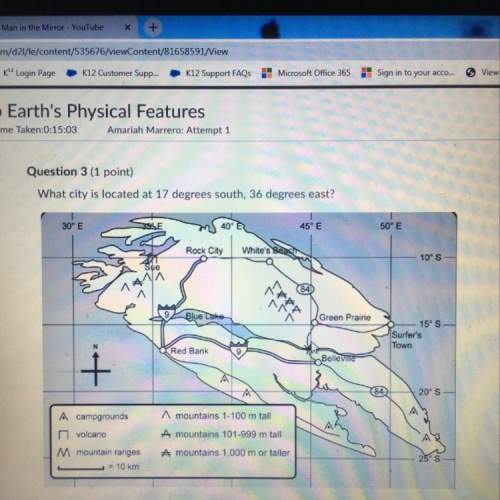
Chemistry, 24.10.2021 04:20 maevemboucher78
CH3OH(g) —> CO(g) + 2 H2(g)
DH° = +91 kJ/molrxn
The reaction represented above goes essentially to completion. The reaction takes place in a rigid, insulated vessel
that is initially at 600 K.
A sample of CH3OH(g) is placed in the previously evacuated vessel with a pressure of P1 at 600 K. What is the final pressure in the vessel after the reaction is complete and the contents of the vessel are returned to 600 K?
(A) P1/9
(B) P1/3
(C) P1
(D) 3P1

Answers: 3
Another question on Chemistry

Chemistry, 22.06.2019 06:30
(1.6 × 10-19)(5.0 × 106) = c × 10d identify the missing numbers below to show the result of multiplying the numbers.
Answers: 1

Chemistry, 22.06.2019 06:30
Ineed someone to see if my answers are correct! if any are wrong let me know what the correct answers would be and how to get that answer! 1. how many moles of sodium chloride are in 28 grams od nacl? a. 265 mole naclb. 856 mole naclc. 479 mole of nacld. 1.2 mole nacl < my choice2. 734 grams of lithium sulfate (li2so4) are dissolved to make 2500 ml of solution what is rhe molaratiy? a. 2.67 mb. 4.56 mc. 3.89 m < my choiced. 1.78 m3. how many grams of cacl2 would be dissolved in 3.0 l of a 0.50 m solution of cacl2? a. 250 g cacl2 b. 166.5 g cacl2c. 113.65 g cacl2d. 98 g cacl2 < my choice4. suppose you had 58.44 g of nacl and you dissolved it in exactly 2.00 liters. the molarity if the solution would be 0.5 mtrue < my choicefalse 5. i would need 22g of naoh to make a 3.0 m solution using 250 ml of solvent.true < my choicefalse6. identify the solute: you have a .0195 m solution made from using 6.5 g of solute and 3 l of solvent. identify the solute by solving for molar weight.a. the solute is nacl because the molar weight is 58.43 g/mol < my choiceb. the solute is h2so4 because the molar weight is 98.06 g/molc. the solute is cacl2 because the molar weight is 111.11 g/mol
Answers: 1

Chemistry, 22.06.2019 08:00
Why is the bond angle in a water molecule less than the bond angle of methane? a. the central oxygen atom in water has two lone pairs of electrons, whereas the central carbon atom in methane has no lone pairs. b. the central hydrogen atom in water has one lone pair of electrons, whereas the central carbon atom in methane has two lone pairs. c. the central oxygen atom in water has four lone pairs of electrons, whereas the central carbon atom in methane has only one lone pair. d. the central oxygen atom exerts more repulsive force on surrounding atoms than the central carbon atom in methane does. reset next
Answers: 2

You know the right answer?
CH3OH(g) —> CO(g) + 2 H2(g)
DH° = +91 kJ/molrxn
The reaction represented above goes...
The reaction represented above goes...
Questions

Mathematics, 05.02.2022 19:10


Mathematics, 05.02.2022 19:10



Mathematics, 05.02.2022 19:10

Mathematics, 05.02.2022 19:10


Advanced Placement (AP), 05.02.2022 19:20




Computers and Technology, 05.02.2022 19:20

Mathematics, 05.02.2022 19:20

Social Studies, 05.02.2022 19:20


Mathematics, 05.02.2022 19:20

Mathematics, 05.02.2022 19:20

Mathematics, 05.02.2022 19:20

Biology, 05.02.2022 19:20




